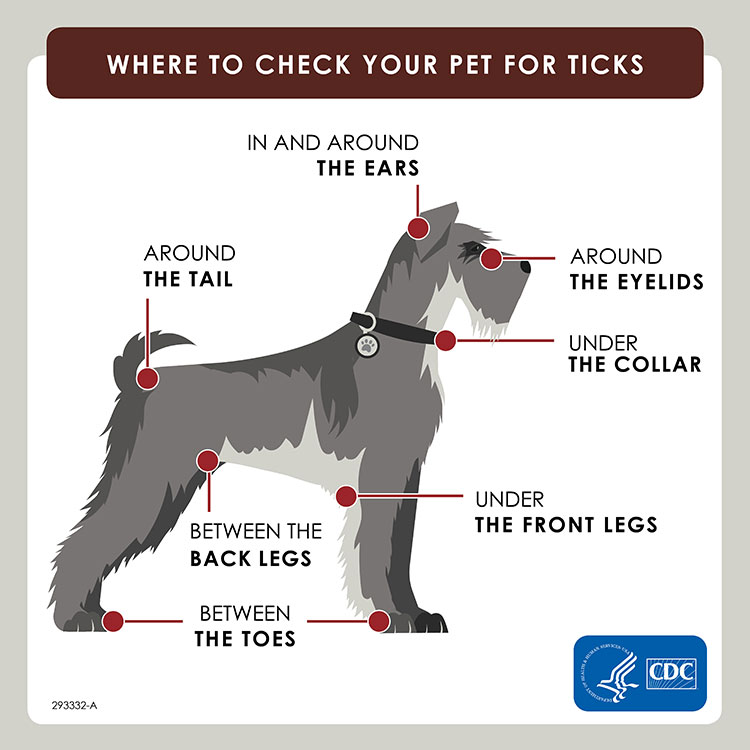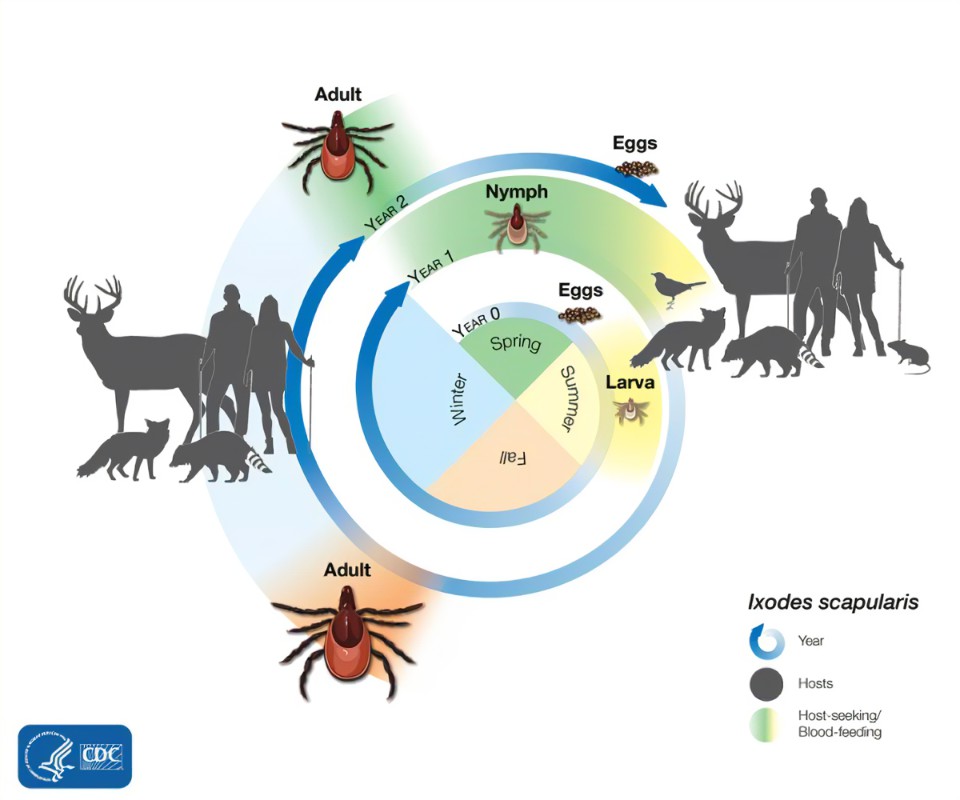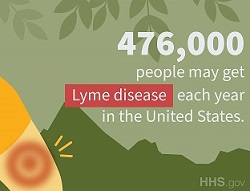Tickborne Diseases
Lyme disease and other tickborne diseases are spread to humans and animals by the bite of a tick with the disease.
Lyme disease is the most common tick-borne illness, approximately 476,000 people may get Lyme disease each year in the United States. If you are spending time outdoors, remember to use an effective insect repellent, wear protective clothing and perform tick checks often. Ticks are active any time the outside temperature is above 40°F and they are not covered by snow. Tick exposure can occur year-round, but ticks are most active during warmer months (April-November).
There are five different tickborne illnesses in New Hampshire:
- Lyme disease (most common reported tickborne disease)
- Anaplasmosis
- Babesiosis
- Powassan virus and
- Borrelia miyamotoi.
Other tickborne diseases such as ehrlichiosis, tularemia and Rocky Mountain Spotted Fever can be caught when traveling to other parts of the country, including other New England states.
Lyme disease, anaplasmosis, babesiosis, B. miyamotoi and Powassan virus are transmitted by the bite of the black-legged tick (lxodes scapularis), formerly known as the deer tick.
- Black-legged ticks have four life stages: eggs, larvae, nymphs and adults.
- The black-legged tick nymphs are most active in the late spring through summer months (most often May- August) and are the most likely to give humans tickborne diseases.
Symptoms
Many tickborne diseases will present, at first, with nonspecific symptoms that may include:
- Fever,
- Chills,
- Malaise (not feeling well),
- Headache,
- Muscle and joint pain, and
- Lymphadenopathy (enlarged lymph nodes).
Some may also present with other systemic (body systems) symptoms, such as:
- Neurological,
- Cardiovascular, and
- Gastrointestinal symptoms.
Powassan virus infection, in particular, can progress to meningoencephalitis (inflammation of the brain and membranes surrounding the brain and spinal cord).
- About 10% of Powassan encephalitis cases are fatal (cause death).
- About half of those who survive the clinical disease have permanent neurological sequelae (nervous system injury/damage).
For more information about specific clinical syndromes please review the following:
Who can get tickborne diseases?
People of any age can get tickborne diseases and it can be serious.
What is the best way to keep from getting a tickborne disease?
Clothes
-
Wear light-colored clothes that covers arms and legs so ticks can be more easily seen.
-
Tuck pants into socks before going into wooded or grassy areas.
-
Permethrin is highly effective at repelling ticks on clothing; it is not meant for use on skin.
-
Apply insect repellent (20-30% DEET) to exposed skin. Other repellent options may be found here.
When outside
-
Avoid tick-infested areas when possible and stay on the path when hiking to avoid brush.
-
Outdoor workers in NH are at particular risk of tickborne diseases, and they should be reminded about methods of prevention.
-
Encourage landscape or environmental management to reduce tick habitat and encounters.
After you go outside
-
Perform daily tick checks to look for ticks on the body, especially warm places like behind the knees, ears, groin, belly button, and the back and neck.
-
Shower soon after returning indoors to wash off any unattached ticks and check clothes for any ticks that might have been carried inside. Placing dry clothes in the dryer on high heat for ten minutes (one hour for wet or damp clothes) effectively kills ticks.
-
Pets returning inside may also bring ticks with them. Performing tick checks and using tick preventatives on pets will reduce this.
There are additional resources available to educate your patients about how to reduce their risk of tick encounters and tick bites.
What do I do if I am bitten by a tick?
Remove ticks promptly using tweezers.
-
Tick removal within 36 hours of attachment can prevent Lyme disease, but the spread of other tickborne diseases can happen with shorter periods of attachment time. Tick Bite: What to Do (cdc.gov)
Monitor for signs and symptoms of tickborne diseases for 30 days after a tick bite.
-
Patients should contact their healthcare provider if symptoms develop.
-
If you are bitten by a tick, remove that tick as soon and as safely as possible. As always, if you have any questions or concerns about a tick bite, contact your healthcare provider(s).
The New Hampshire Department of Agriculture, Markets and Food identifies ticks, for FREE, if you are a New Hampshire resident. The goal is to see where the tick species in NH are located across the state.
-
If you would like to have your tick identified, fill out the Tick ID Submission Form, follow the steps to get the tick ready to be mailed and mail the tick and form as described in the steps.
-
Ticks submitted will not be tested for ANY diseases.
Educational Materials
Tickborne Disease Prevention Lending Library Activity Kit
The Lending Library Activity Kit has fun and educational hands-on activities for elementary-aged children (K-3) to learn about ticks and tick safety.
These kits are available for loan. For more information, please see the Lending Library Activity Kit Introduction.
Tickborne Disease Prevention Educational Curriculum Kits
The Tickborne Disease Curriculum Kits consist of various lessons that are broken down into three grade levels with a primary focus on personal protective measures.
Each lesson fits within the Common Core State Standards, the Next Generation Science Standards performance expectations, and the NH Curriculum Frameworks for science and health.
Educators are also invited to provide feedback on the lessons by completing the feedback form and either fax it to 603-271-0545 or email it to vectorborneNH@dhhs.nh.gov.
CDC has developed a communications tool kit to help state and local health departments prevent Lyme disease. Sign up to receive automated notices when new items become available.
Educational Materials | Lyme Disease | CDC
CDC has developed 4 new online training modules that offer continuing education (CE):
Diagnostic Testing and Treatment - Healthcare Providers
Refer to CDC’s tickborne diseases Reference Manual for Healthcare Providers for a helpful summary of geographic risk, clinical presentation, diagnosis, and treatment recommendations for various TBDs (note: this reference is expected to be updated to a 6th edition in the coming months).
- An erythema migrans (EM) rash is diagnostic of Lyme disease but can present in different forms: The Many Forms of Lyme Disease Rashes (Erythema Migrans)
Tickborne Disease Continuing Education | Ticks | CDC
- Ehrlichiosis and Anaplasmosis Continuing Education
- Lyme Disease Training Modules
- Clinician Outreach and Communication Activity (COCA) Webinar
- Rocky Mountain Spotted Fever Continuing Education
- Viral Tickborne Disease Continuing Education
Lyme disease
- CDC Lyme disease website and infographic on Lyme Disease Prophylaxis After Tick Bite
- IDSA 2020 Guidelines for the Prevention, Diagnosis and Treatment of Lyme Disease
Anaplasmosis
- CDC Anaplasmosis website
- CDC guidance for health care providers on the Diagnosis and Management of Tickborne Rickettsial Diseases (including Anaplasmosis)
Babesiosis
Borrelia miyamotoi
Powassan virus
Lyme Disease in New Hampshire
Fact Sheets
Preventing ticks on your pets
Dogs are very susceptible to tick bites and tickborne diseases. Talk to your veterinarian about tickborne diseases in your area and the best tick prevention products for your dog. Remember to check your pets for ticks daily.
Preventing ticks on your pets | Ticks | CDC






